Part 1: Dream Presentation
Dreams often serve as emotional mirrors, reflecting our subconscious tensions in ways that waking logic cannot. This particular dream offers a vivid narrative of internal conflict, where the external pressures of military life collide with deeply personal emotional experiences. Consider the following dream presentation, which captures the dreamer’s journey through conflicting landscapes:
In the dream, the dreamer—an infantry soldier—finds himself on a stark contrast of settings. First, he experiences a period of temporary freedom during block leave, transported to Japan where he encounters a woman who represents a profound connection to peace and love. This idyllic interlude is abruptly shattered by deployment and the horror of war, now fought against the very country where he once found solace. The emotional trajectory shifts from romantic bliss to battlefield horror as he encounters his beloved on the opposing side, ultimately shooting her in the stomach. The dream concludes with her death in his arms, a final moment of intimacy amidst destruction, followed by his abrupt awakening to the physical need to urinate.
The narrative’s power lies in its emotional dissonance: the transition from a peaceful, culturally rich setting to a violent conflict zone, the reversal of love into deadly opposition, and the visceral imagery of holding a dying lover while recalling happier times. These elements collectively create a psychological portrait of internal fragmentation and emotional processing.
Want a More Personalized Interpretation?
Get your own AI-powered dream analysis tailored specifically to your dream
🔮Try Dream Analysis FreePart 2: Clinical Analysis
Symbolic Landscape: The Dream’s Core Imagery
This dream is rich with symbolic elements that require careful unpacking. The battlefield itself serves as a primary symbol of internal conflict, representing the dreamer’s struggle to reconcile opposing aspects of his identity. In Jungian psychology, the battlefield often signifies the
